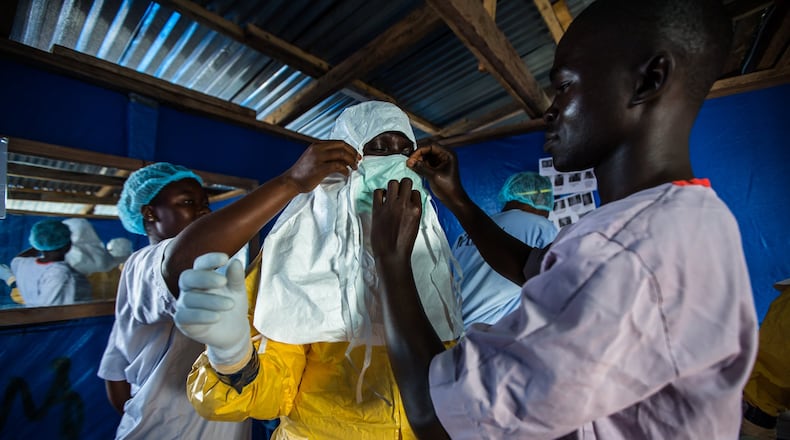A new exhibit at the Centers for Disease Control and Prevention's museum takes a powerful look at what it was like at ground zero of the worst outbreak of Ebola in history.
The CDC's David J. Sencer Museum, believed to be the first U.S. museum to offer an overview of the devastating viral outbreak that killed more than 11,000 people in West Africa, is titled "EBOLA: People + Public Health + Political Will." The exhibit is open now through May 25 at the CDC headquarters in Atlanta.
The exhibition offers a glimpse of public health workers’ experiences during the outbreak. And the CDC was there — working 24/7 to stop the rapidly spreading epidemic even as the death toll mounted in crowded cities and rural villages alike.
Stunning photographs vividly illustrate the severity of the outbreak and the difficult work undertaken by public health workers to bring it under control. Artifacts on display include crosses made to mark the graves of victims, Bibles marked with passages that were interpreted to support Ebola prevention, and T-shirts and posters designed to raise awareness about how it’s transmitted. The exhibit also includes hand-washing stations and special, sophisticated fluid-resistant head covers worn by health care workers to prevent any exposure to the Ebola virus. There are also stories about people who survived Ebola.
All together, the combination of photographs, artifacts, videos and stories presents human faces behind the epidemic.
CDC museum curator Louise E. Shaw said she knew during the outbreak that history was unfolding and took steps to document it for future generations.
“We knew that this story needed to be remembered and told,” Shaw said. “At the end of the day, it was a humanitarian crisis people had to solve.”
In the spring of 2014, CDC first received reports of Ebola virus disease from a remote part of Guinea. Within weeks, a full-blown health and humanitarian crisis had exploded in Guinea, Liberia and Sierra Leone. Thousands were sick and dying and — for the first time in history — Ebola was spreading in crowded urban centers.
A Liberian traveler brought Ebola to Nigeria; another traveler brought it to the United States. It was clear that without a coordinated, massive response, Ebola would spread exponentially, threatening global health security.
In August 2014, Dr. Kent Brantly slowly made his way into Emory University Hospital, becoming the first person with Ebola virus disease treated in the United States — propelling Emory into the international spotlight.
Brantly contracted Ebola while serving as a medical missionary in Liberia, which along with Guinea and Sierra Leone was the epicenter of the worst Ebola outbreak in history. Emory also cared for fellow missionary Nancy Writebol, who worked at the same hospital in Liberia and arrived three days after Brantly. Both recovered.
Credit: John Spink
Credit: John Spink
Meanwhile, the CDC, the United Nations and the World Health Organization, along with international aid organizations, mobilized massive efforts to control the epidemic.
Shaw said the exhibit highlights strategies used to respond to the health crisis, and eventually stop the outbreak.
“I think it is a real testimony to the global community coming together,” Shaw said.
She said lessons learned three years ago have already been put into place in Congo. A recent Ebola outbreak there caused four deaths, but after 42 days, it was all over.
EXHIBIT PREVIEW
“EBOLA: People + Public Health + Political Will”
Through May 25. 9 a.m.-5 p.m. Mondays-Wednesdays and Fridays; 9 a.m.-7 p.m. Thursdays. Free. David J. Sencer CDC Museum, 1600 Clifton Road NE, Atlanta. 404-639-0830, www.cdc.gov/museum. (A driver's license or passport is required for entry. Students under age 18 do not need to show IDs as long as they are accompanied by adults with IDs.) The minimum recommended age for visitors to the exhibit is middle schoolers.
About the Author
Keep Reading
The Latest
Featured




